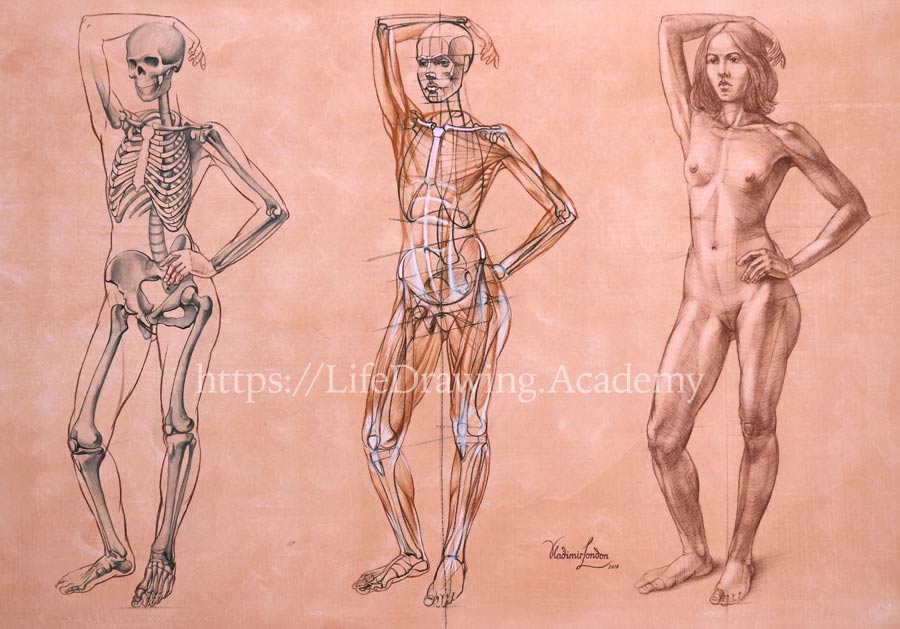How to Draw a Person - Life Drawing
This is your unique chance to get a lifetime academy membership and a dedicated team of art teachers.
Such unlimited personal tutoring is not available anywhere else.
Enroll in the Life Drawing Academy now!
How to Draw a Person Step by Step
Life Drawing by Vladimir London
In this video lesson, you will discover how to draw a model standing in contrapposto with the knowledge of body anatomy and proportions. I will make this artwork on manually toned paper in pencils. Let's begin with the skeletal anatomy of the figure in contrapposto. In a contrapposto pose, most of the figure's weight is supported by one leg. This is one of the most common standing poses in classical art. This time, the model keeps an arm on the hip and another is raised and rests on top of the head.

After marking the figure's top and bottom edges, I divided the figure's height in half.
The pelvis line is tilted.
The top half is halved again. And the top quarter is also divided in half.
I draw in graphite pencil and use very light pressure, so all lines are almost invisible. Do not worry, when it comes to important lines, I will make bolder marks so you can see them.
The head takes a bit more than one-eighth of the figure. In our case, it fits seven times and a bit in the figure's height. The face takes five-sixths of the head height. This measurement is also the distance from the middle of the figure to the pelvis' top.
The cranium's volume is presented as a circle.
Here's how we can locate the pit of the neck. The distance from the pit of the neck to the pubic bone, which is in the middle of the figure, is comparable to the distance from the top of the pelvis to the top of the kneecap. It also measures from the top of the kneecap to the toes.
In previous videos, you have heard these proportions several times, and I hope by now you have memorized them and can use them in life drawing.
The line between the knees follows the pelvis' tilt.
The tilt of the shoulders goes in the opposite direction to the pelvis' inclination.
The axes of legs and arms are marked as straight lines for now. Their angles can be checked by measuring cross-points.
With the main proportions in place, I created this skeleton in watercolor. Skeletal anatomy is not a part of this course. Anatomy for artists is fully explained in the Anatomy Master Class. If you feel you have gaps in anatomical knowledge, you would greatly benefit from that online video course, as it is designed for artists like you, who don't have much time for learning. I will draw outlines of the body around this skeleton, and we will proceed to constructive drawing of a figure in contrapposto. This skeleton will be used to explain the origins and insertions of muscles that influence the body's appearance.
Constructive drawing will be in the same scale as the skeletal sketch. We will repeat steps you are already familiar with. The vertical axis is divided in half.
The pelvis' axis is tilted. The top quarter of the figure is halved, and the head takes a bit more than the top division.
The height of the face is used to locate the top of the pelvis. The distance from the top of the pelvis to the toes is halved. This is the top of the kneecap.
The level of the eyes divides the head in half. Above it is the level of the eyebrows. Midway from the eyebrows to the chin is the base of the nose. Thus, the face is divided into three equal parts by the level of the eyebrows and the base of the nose.
The first pair of ribs is marked as an oval. The height of the breastbone is comparable to the face's height.
In contrapposto, the ribcage is quite close to the pelvis' top at the compressed side of the torso. The axis of the shoulders counterpoises the tilt of pelvis. The spinal column is curved.
The axis of the front hip bones follows the pelvis' tilt, as it is one solid unit.
How to draw a pelvis and its anatomy is fully explained in the Anatomy Master Class video lessons. The height of the pelvis is comparable to the height of a head. A pelvis is always slightly wider than the ribcage.
The hip joints' level is just above the pubic bone. The supporting leg axis spans from the hip-joint to the footprint. The thigh bone has a slightly different tilt. I will depict this bone. It curves slightly forward to compensate for dynamic forces during walking, running, and jumping.
The condyles of the leg bones at the knee are wider than the bones' shafts to reduce pressure on the joint. At the lateral side of the shinbone, there is a slender calf bone, which does not take part in the knee joint. Its lower end is the lateral ankle, which is lower than the medial ankle that belongs to the shinbone.
The model's left arm is in pronation. This is when the two forearm bones are crossed. The model's right arm is in supination. In this position, the bones are parallel to each other. The length of an elbow bone is slightly bigger than the height of a head.
I will now make one more drawing of the same pose...
[ The full lesson is avaibale to Life Drawing Academy members ]
This is your unique chance to get a lifetime academy membership and a dedicated team of art teachers.
Such unlimited personal tutoring is not available anywhere else.




